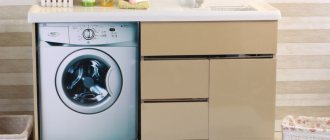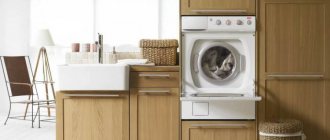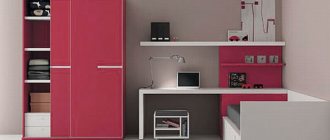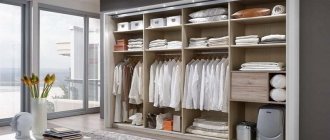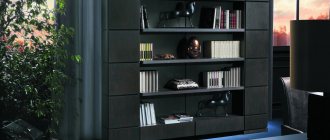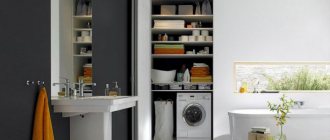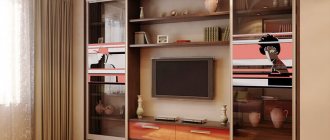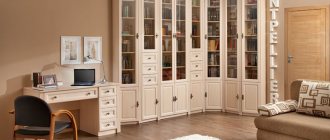Large household appliances, compact furniture, small space are an eternal problem faced by apartment owners. Traditionally, the layout of a living space includes a small kitchen, bathroom or toilet. Therefore, there are few options left for placing the washing machine. To arrange household appliances compactly, beautifully and conveniently, you can use a built-in or stationary cabinet for a washing machine. The product is made to individual sizes, which eliminates difficulties with using the unit and problems during installation.
Cabinet for a washing machine in the bathroom - features and benefits
Furniture manufacturers offer a suitable solution. It is enough to install a cabinet for the washing machine in the bathroom. This will help you create an aesthetically pleasing and well-maintained workspace.
There are other advantages:
- If the usable space allows, you can hide a dryer, water heater and other equipment in such a cabinet;
- Aesthetics. The cabinet will help hide all the pipes and cables necessary for the proper operation of the equipment. The low attractiveness of such elements can seriously spoil any interior;
- Everything you need is nearby. Additional sections with adjacent shelves allow you to store laundry detergents, conditioners or a basket with dirty laundry nearby;
- Simplify the cleaning process. No need to wipe between the bulky machine and the water pipe;
- Reduce noise levels. The ribs dampen some noise and vibration. In apartments with good audibility this will not be superfluous.
Pros and cons of placing a washing machine in the kitchen and tips for using it
Placing a washing machine in the kitchen is most often a necessary measure, which has its pros and cons. Let's start with the positives.
- In addition to freeing up space in the bathroom, you will create an additional work surface in the kitchen. Another bonus for a large family is the ability to do laundry at any time, regardless of whether the bathroom is busy or not.
However, when moving the machine to the kitchen, you need to be prepared to put up with some inconveniences:
- The noise of the machine during spinning and draining will interfere with communication during meals and drown out the TV.
- The smell of washing powder and other cleaning chemicals is not very appropriate and useful where food is stored, and where household members eat and relax.
- To wash dirty clothes, you will first have to look into the bathroom (or another room where the laundry basket is stored), sort and load everything you need into a basin, grab the required portion of powder along the way, and only then proceed to the kitchen.
However, all these inconveniences are not critical and can be completely solvable. Here are some tips to help you quickly get used to the kitchen-laundry area.
- To prevent noises and smells from disturbing you during gatherings in the kitchen, try to start washing clothes at night/evening or in between meals.
- It is best to store washing powder either in a closet in containers with a tight lid (say, under the sink), or in another room altogether (in the same bathroom, for example).
- To prevent the powder from spilling past the tray every now and then, simply replace it with liquid laundry detergent, which, by the way, always dissolves completely.
- To make the machine make as little noise as possible, adjust its legs well.
- If you're building your kitchen from scratch, try to use ceramic tiles/porcelain flooring rather than laminate or hardwood flooring. After all, firstly, it is not afraid of possible leaks, and secondly, it minimizes the noise of the machine during washing.
See also the material: Guide to choosing an automatic washing machine.
Types of cabinets for washing machines
Wall cabinet above the washing machine
Models of cabinets above the washing machine in the bathroom can be of two types:
- Blocks with shelves that easily fit underneath are suspended above the washing machine. Suitable for very compact spaces;
- The folding section goes around the washing machine in the shape of the letter G. At the bottom side there is usually a compartment with a basket for dirty laundry. There is also a compartment with shelves at the top. A more practical modification. But this requires more space. Weight increases.
All of them require fastening directly to the wall, without resting on the floor. To do this, choose only solid walls with high-quality finishing. It is recommended to hang on supporting structures. Overloading a weak wall can cause it to partially collapse.
Lockers that do not exceed the width of the machine itself look harmonious. The height can be any. When hanging the cabinet, leave enough space between the bottom and top of the washing machine. This way you can completely bypass the difficulties with vibrations and overheating.
Pay attention to the selection of fasteners. Weak hinges without hinges will not fit in a full wooden cabinet. Whereas a plastic sash cannot be secured with complex corners of increased strength. Focus on the weight of the base material. Fasteners must be moisture resistant.
Floor-standing models of cabinets for washing machines for bathrooms
The next popular type is a cabinet for a washing machine in the bathroom. They have no bottom, and the back wall may be completely or partially absent. This is due to the heavy weight of the equipment and the need for pipe drainage. A rarer type is the model where the technique is at the top. It looks original, but will cause you a lot of hassle if you have to lift the laundry when you load it into the drum. It is also inconvenient to pour the powder, since you will not see the compartment under it at all.
The upper niche for equipment creates a danger of it falling. The manufacturer must be truly serious, and the quality of the materials must be impeccable. If you decide to install only this option, constantly monitor the fasteners and strength of the screed.
Compared to wall-mounted ones, the floor will require more space. But they will provide you with a complete and spacious storage system. It is not necessary to focus on a load-bearing wall. Choose free.
The height of the cabinet can vary from 1.7 to 2.1 meters. The width depends on whether the cabinet has one or two sections. But you can be sure that it will be at least 65 cm.
Built-in models
A built-in cabinet for a washing machine in a bathroom is a rare occurrence. This is due to lack of space. But if you are lucky enough to have a spacious bathroom, then installing such a cabinet will bring you many benefits. Offers maximum flexibility in organizing shelves and drawers. You can choose everything strictly according to your taste. The absence of a frame will slightly increase the niche for the car. It’s a pity, but such a space-efficient option is very difficult to place where it is really needed. Be sure to level the walls and tiles. If there are significant differences in floor level, a concrete screed will help. If the problems are related to old, protruding and chipped tiles, it is easier to disassemble them than to straighten them.
Features of choosing a cabinet for a washing machine
The most important element in terms of size is the size of the niche for the equipment. They should exceed the size of the camera body by 2-5 cm. At the back you will need to retreat 10 cm, this will ensure normal air circulation. In addition, the furniture will not experience vibrations in rotation mode. On average, the height of such a device reaches 90 cm, and the width and depth are 60 cm.
It is also taken into account whether the machine will be closed by dampers. If so, then there should be 2 of them. A large door can extend furniture hinges. The depth still depends on the thickness of the material. In this regard, built-in washing machine options are ideal. They have hinges for hanging doors. But this can make it difficult to fall asleep in the dust. In this case, pour it into the trash. This technique is allowed by most manufacturers. Also keep in mind that some materials may have a warming effect. This is not particularly desirable.
It doesn't matter whether you buy a cabinet in a store or create one to order. You must first buy the equipment. This will avoid all the difficulties with subsequent rework.
Purpose
Saving space is a decisive factor when choosing furniture for general built-in appliances. A competent project, the original design of the wardrobe model allows you to create the illusion of free space, as well as arrange the products compactly and ergonomically. In most cases, washing machines are installed in the kitchen or bathroom, built into specially designated niches or modules. This cabinet helps solve the following problems:
- saving space. The real challenge that almost all homeowners face is the space-saving setup of large apartments. Installing a washing machine inside a cabinet frees up space;
- aesthetics of the work area. Regardless of the room in which the furniture will be installed (kitchen, bathroom), the room “wins” in aesthetics. Equipment will not attract the attention of guests if it is hidden behind beautiful furniture doors;
- rational use of free space. There are furniture models for household appliances with additional sections, shelves, and drawers. The internal content depends on the size of the installation space. Inside you can install baskets, nets, shelves for storing detergents;
- spectacular room design - furniture for rooms with high humidity can be made from moisture-resistant materials, doors can be decorated with decorative facades, the product can be designed in a suitable style so that all the furniture in the room looks like a single whole;
- Maintain order and ease of cleaning in the room. The neat arrangement of equipment inside the cabinet simplifies the process of wet cleaning in the bathroom or kitchen. Housewives can place various personal hygiene items and household chemicals on the shelves.
An additional advantage of installing a washing machine in the interior of a cabinet is the sound insulation of the operating equipment. Typically, washing machines with a spin option are noisy. Furniture walls create a certain barrier to noise and vibrations, performing sound-absorbing and sound-proofing functions. The top panel of the built-in cabinet under the sink can be used as a convenient shelf for storing various accessories, small items and hygiene products.
Design
Modern cabinet designs are very diverse. They are made from different materials, vary in shape and size, have all sorts of colors, include patterns and illustrations. This allows you to adapt the furniture to almost any existing interior. It’s easy to verify this; just look at the products of well-known brands, for example, ikea.
When choosing suitable furniture for a washing machine in the bathroom, you should take into account the size of the equipment, the design features of the room, and the prevailing style. It is advisable to install sections for a large floor or wall cabinet with many shelves when homeowners have no doubt about saving space. Otherwise, it is better to use a small cabinet or pencil case.
The best option, distinguished by its beauty and luxury, would be a massive oak cabinet. A product made from natural wood will last quite a long time. But it should be noted that its price is very high. If the family budget does not allow you to purchase products made from natural wood, you can pay attention to structures made of MDF or chipboard, treated with special waterproofing agents.
Bathroom shelves
If you couldn’t fit an automatic washing machine (WMA) under the sink, you can still save space. Many users use the lids of their washing machines as a surface for placing bath accessories, microwaves, kettles and other items - despite the prohibition in the instructions.
Look up and see wasted space - above the washing machine. Why not add a few shelves here? Or even a small locker? It turns out that this idea has long been picked up by manufacturers - they offer ready-made solutions that differ both in design and in materials of manufacture.
Varieties
Shelves above the SMA can be made:
- Open. They do not have doors; any object is easy to reach.
- Closed. If you are annoyed by the color cacophony of mismatched jars and bottles, you can hide them behind the shelf doors. By combining the shelves with common walls and doors, you get a wall cabinet with shelves.
Suitable materials:
- Plastic. The shelves are not afraid of moisture and are cheap. But not strong enough. And most importantly, mold can grow on plastic. It is recommended to choose perforated products - then moisture will not collect on the surfaces.
- Metal. Durable and stylish. But you only need to choose coated metal that is not susceptible to corrosion. Stainless steel and chrome-plated metal are suitable. For interiors in Provence and country styles, forged versions, as well as bronze products, may be suitable.
- Ceramics and glass. These are usually small decorative items. They are not afraid of moisture, but are very fragile. As a rule, ceramics and glass are used together with wood or metal.
- Tree. Fiberboard and MDF sheets are most suitable - they are durable, light, and look respectable. Minus - susceptible to moisture. But you can use wood impregnated with special compounds that repel moisture.
The shelves are attached - in the bathroom or in the kitchen, using hinges, brackets and corners. Also, shelves can be a single structure united by common components.
The cabinets above the washing machine can have different designs - the imagination of the creators is not limited by anything, you only have to take into account the cost of materials and the size of the room. The cabinet can be made:
- Mounted. This is the simplest option. By making it deeper, you can even hide meters or communications in it.
- Free standing. In appearance it looks like a cabinet. The shelves are combined by side walls into a single whole.
- Floor. This is essentially a shelving unit with open shelves. An example of such a solution is in the photo below.
Types of cabinets and placement methods
The choice of a specific cabinet for a washing machine depends on several parameters. First of all, the type of washing machine is taken into account. Top-loading models with an opening lid cannot be hidden under a sturdy countertop or sink. Floor and wall-mounted furniture options are suitable for these products.
Front-loading units can be placed in built-in, floor-standing, or built-in cabinets. You can buy ready-made furniture along with a washing machine, but it is better to make them individually, taking into account the dimensions of the room, the dimensions of the product, sections and the necessary additional shelves included.
Mounted
Wall cabinets can be part of a furniture set or serve as a separate element. In terms of design, they are practically no different from floor-standing models; they have back and side walls, an open or closed front. The main feature is the method of mounting the module, which should not touch the floor. The cabinets are attached directly to the wall using special fasteners.
When choosing a suitable model, special attention should be paid to its size. The width of the furniture must correspond to the technology. At the same time, wall cabinets can be placed on top of top-loading and front-loading machines. Inside you can place shelves, rods, drawers where personal hygiene items, bathroom accessories, and household chemicals are stored.
Among the main advantages of this type of cabinets are their small size, limited access for children to objects inside, and they also allow rational use of useful wall space. This is an ideal option for small spaces, however, due to their design features, these models do not allow storing heavy items.
Cabinets can only be installed on hard surfaces. The most suitable place is a load-bearing concrete or brick wall. Fragile plasterboard partitions cannot withstand the load.
Floor-standing
Basic cabinets are the most popular among customers. They are reliable, easy to use and can have many additional sections. For small bathrooms, cabinets are used, the minimum width of which is 60 cm, and the height is limited only by the ceilings. However, narrow and tall cabinets should not be overloaded, as they may tip over due to vibration.
An alternative to tall cabinets are cabinets. The lid of the most compact of them can be equipped with a washbasin, and a washing machine can be placed under it. There are also models on sale with a countertop with a built-in sink. The height of such furniture is only 90-95 cm, depending on the size of the built-in equipment.
Finished products vary in color, shape, material, and size. In spacious rooms, you can build durable large cabinets, which consist of drawers, sections for washing machines and dryers, and upper shelves. Based on the way the furniture is positioned relative to the wall, linear and angular models are distinguished and based on the type of doorway: hinged and sliding.
Built-in
Built-in wardrobes do not have a back wall, and some models do not even have side walls. Their function is performed by the walls of the room themselves. There are panel and frame structures. The first type is usually installed in a niche or in one of the free corners. The second type is most often located along the wall; it can be used as a separate type of furniture.
The height of the products is usually limited by the ceiling, which allows for the most efficient use of free space. The main advantage is stability, which allows you to place equipment even on the top shelves. The main disadvantage is stationarity. During repair work, disassembling the compartment is quite problematic.
The designs look very modern and attractive, but experts recommend installing such a cabinet only after careful planning and accurate completion of all measurements. The strength of the furniture allows you to place 2 cars at the same time. But to avoid loosening during operation, it is better to choose quiet models with minimal vibrations.
Kinds
The optimal solution for small rooms is a cabinet for a washing machine. If you draw up a successful project, you can find space to install internal shelves, cabinets, and a symmetrical arrangement of the drying machine. The design of the furniture depends on the availability of free space and the size of the washing machine. In modern housing, equipment is placed in the kitchen, bathroom, and hallway. These conditions determine the design features of cabinet models, the choice of materials and decoration, and the design of doors, if they are provided for in the design drawing.
According to the material of manufacture
To install a washing machine, you need to take into account the humidity of the room when choosing materials for making furniture. Installing equipment in the hallway allows you to implement any solution, but for the bathroom you need moisture-resistant materials with a long service life. Another important point is the dimensions and weight of the machine. To install heavy models, it is necessary to use durable base materials, high-quality fittings, and stable structures. Types of cabinets for washing machines according to the material they are made of:
- MDF boards are a standard solution for the kitchen and hallway, but in the bathroom furniture parts at the joints are exposed to moisture and do not last long. An MDF cabinet can be given any shape, choose an interesting color scheme, or use spectacular decor;
- natural wood treated with special moisture-repellent compounds. Wooden cabinets fit perfectly into the interior; they are distinguished by their noble shade and environmental friendliness of the natural material. Furniture made from natural wood is stable and durable, but does not tolerate moisture;
- glass combined with metal is an interesting solution for installing built-in units. The washing machine behind the glass doors looks unusual, neat, and expensive. Modern glass processing technologies give the material additional strength, hardening, texture, matte, satin effect;
- plastic cabinet is a ready-made option. Such models are not uncommon in houses and apartments due to their low cost of products. Plastic does not deteriorate from exposure to moisture, and mold and mildew do not appear on it. You can choose a cabinet for a washing machine of any color. A significant disadvantage of plastic furniture is its fragility;
- furniture panel is an unusual, but completely justified option for installing a washing machine in the kitchen or hallway. Furniture board is a natural material made from oak, beech, ash, and birch wood. The tree is cut into small strips, which are securely glued together. The shield is durable, strong, beautiful.
The materials used to manufacture cabinets for built-in appliances must meet the operating conditions of the furniture. Moisture-resistant materials are suitable for wet rooms; in rooms with normal humidity and stable temperature conditions, you can install furniture from any materials. Functional content, equipment, and installation location are of great importance.
Wood
MDF Glass
Chipboard
By location
There are not many places in an apartment, house, or country house where you can install a cabinet for a washing machine. Of course, at the whim of the homeowner, equipment can be placed even in the living room, but such a solution is irrational, aesthetically unattractive and impractical. To install large equipment, you need to select suitable furniture and install the product in the most convenient place. There are only four acceptable options for installing washing machines in a closet - bathroom, kitchen, hallway, toilet (extremely rare). In addition, furniture can be arranged in different ways in the free space:
- wall-mounted option - the cabinet does not touch the floor with its legs, it has a countertop under which the washing machine is placed. On one side of the furniture structure there are drawers or shelves. There are no doors, the model is suitable for mounting front-loading machines. It’s difficult to call furniture a full-fledged closet, but the solution is often implemented in narrow bathrooms, combining appliances, a sink, and shelves. Another option is to mount an oversized washing machine with a small load on the wall;
- a base cabinet is the most common way to integrate household appliances. The free-standing design allows you to hide communications, a washing machine, and place hanging shelves, racks, and other furniture above it. Suitable for completing bathrooms, kitchens, corridors. If the room's capabilities allow you to install doors, the unit will not become dusty or dirty. A small cabinet is sometimes called a washing machine cabinet due to the compact size of the product;
- tall cabinet column (pencilcase) built-in or stationary type. The model is placed in a narrow space of a bathroom, kitchen, or less often a hallway. The lower part of the furniture is used to install a washing machine, on which a dryer is mounted. On the mezzanine tier there are shelves for storing household chemicals, bath textiles, cosmetics and other necessary items. The upper module can be equipped with hinged doors;
- module or niche of a kitchen unit. Options for permanent installation of furniture, full or partial embedding are allowed. When fully built-in, the machine can be hidden behind the front doors, giving the room a neater look, the effect of a spacious room. There is a wide choice of installation of appliances - the end of a kitchen unit, a bar counter, if the machine is vertical loading, a module with closed doors. When partially built-in, the equipment is placed under the tabletop in a free niche.
In a narrow hallway, you can install a built-in wardrobe across the width of the room, place a washing machine in the lower part, and use the upper tier to install a mirror with lamps, shelves, and a mezzanine for accessories. Based on their location, cabinets for washing machines are conventionally classified into floor-mounted, wall-mounted, column-mounted (pencil cases), cabinets, and based on the installation method - free-standing stationary-type models, fully or partially built-in furniture.
Column
Floor
Modular
By design
The design of cabinets for built-in appliances is determined by the size of the furniture and the installation location. At the same time, the aesthetics of the model should correspond to the overall style and design of the room. Ready-made furniture for washing machines can only be conveniently placed in large rooms. A variety of design ideas can be realized in custom-made projects. The most popular cabinet design solutions:
- corner design - two sides of the cabinet are in contact with adjacent walls of the room, two more serve as front panels. One front panel can be equipped with doors, and the second can be left open to accommodate a washing machine and shelves;
- straight built-in wardrobe from floor to ceiling with two or three sections. An open niche is left in the lower left or right corner for installing a washing machine. The model will fit compactly in the hallway;
- narrow cabinet for installation in a bathroom with extension. The lower part of the furniture accommodates a washing machine, closed with doors; in the upper superstructure there is a mirrored cabinet with shallow shelves for small items;
- vertical cabinet for installing equipment with a front loading drum. The furniture belongs to the classic free-standing stationary type products. Depending on the availability of free space, the product is equipped with one or two doors;
- In most cases, the horizontal floor option is installed along the length of a free wall, combined with a sink and functional shelves. The machine can be closed with doors or located in an open niche.
When choosing a cabinet design, you need to consider the presence of doors. If the furniture is equipped with hinged doors, there should be enough space for the doors to open freely.
In a small area, you can install a cabinet with folding fronts or hang a panel that moves along the top guide like a sliding compartment system. Too narrow rooms require a non-standard approach to installing equipment - it is convenient to use a cabinet with a washbasin built into the countertop.
Vertical
Horizontal
Straight
Angular
To size
The cabinet for installing appliances is made according to the dimensions of the washing machine. The dimensions of the model are the starting point when choosing the design, shape, and size of furniture. All automatic machines are classified into vertical (top loading) and horizontal (front drum) units. This must be taken into account when designing furniture. In addition, models of equipment can be built-in, with removable top covers, or free-standing. You can place any washing machine in the interior space of the cabinet if you correctly calculate the dimensions of the equipment and connect the communications. Features of calculating furniture dimensions based on unit dimensions:
- frontal full-size model - standard height is 890-900 mm, there are options with a height of 850 mm. The depth of the machine is standard 600 mm, there are narrower models with a smaller drum capacity - 350-400 mm, ultra-narrow ones - 320-350 mm. At the same time, almost all frontal models have a width of 600 mm, except for compact copies (680-700x430-450x470-500 mm);
- The overwhelming majority of vertical models have a significant height of 850-900 mm, compact dimensions in depth - 600 mm and width - 400 mm. When installing vertical models, no additional space is required on the front side of the cabinet, that is, in the area of the doors. Often the convex hatch of the drum prevents the installation of front-facing equipment - there are no such problems with vertical units;
- The dimensions of the cabinet must correspond to the dimensions of the equipment with an additional gap between the walls of the furniture and the body of the machine of 20-30 mm, so that when vibration occurs during the spin cycle, the unit does not break the furniture structure. It is not recommended to install a cabinet with a plinth - the equipment will vibrate, gradually moving to the side, front or back walls of the furniture;
- installation of horizontal cabinets involves installing furniture under sinks in the bathroom. Then a compact machine (700x450x500 mm) is suitable for installation. If the unit is installed under a kitchen worktop, its height must be at least 1000 mm - the tabletop does not lie on the body of the machine, but is attached to the rear wall. For vertical units, you need to leave room for opening the hatch;
- installation of cabinets of a vertical design allows you to install a module measuring from floor to ceiling, but the width of the product must be at least 650 mm, the depth varies from 350 mm (narrow appliances) to 650 mm (deep front models). For vertical units, a height of 850-900 mm and a cabinet depth of 600 mm plus a gap of 20-30 mm on the side are required.
Manufacturers of built-in appliances indicate dimensions for installation in the instructions. If you need to install a stationary unit, the furniture is made according to the dimensions of the machine, taking into account the space for the convex drum hatch if the model is mounted behind closed facades. To compensate for the corners of the room and the furniture set, it is convenient to install a structure with radius doors; select a washing machine with a convex front panel and place it in a cabinet niche.
Materials and components for making a cabinet for a washing machine with your own hands
To make a cabinet for a washing machine with your own hands, it is better to choose moisture-resistant materials. This is especially important when designing furniture for bathrooms, where there may be high humidity.
Let's consider all possible materials of manufacture:
Chipboard. If the washing machine is built into the kitchen furniture, you can do this using regular high-density laminated chipboard. Without direct contact with water and without exposure to condensation and steam, chipboard can well serve as the main body material for a cabinet or toilet.
MDF. Laminated MDF panels are much more expensive than chipboard, but they fully justify their cost in terms of moisture resistance and convenience in the manufacture of bathroom furniture. But mainly MDF is used as a material for facades and tabletops, for decorating furniture facades. MDF can be covered with plastic or painted with enamel. In cheaper options, it is covered with PVC film.
Beam and panel for furniture. With a varnished or varnished surface, impregnated wood serves as a fairly moisture-resistant material. In addition, wood allows you to create lightweight and practical designs of shelves and shelving that fit beautifully and harmoniously into the bathroom interior. If desired, they can be supplemented with plastic and MDF countertops, chipboard shelves, glass, and metal baskets. You can make a radically different cabinet for a wooden washing machine with your own hands - a massive and durable structure, using a thick furniture panel.
Fake diamonds. It is primarily used to create streamlined, streamlined countertops with integrated sinks. Can also be used for furniture edges and shelves in combination with other furniture materials.
Plastic panels, drywall, tiles and other finishing materials. A built-in cabinet for a washing machine can become part of the bathroom interior. For this purpose, its body was built using repaired construction and finishing materials. The inside of the wardrobe can be supplemented at your discretion with shelves, drawers, baskets, and the facade can be decorated with curtains, sliding or hinged doors.
Metal and plastic construction. Cabinets made of metal profiles with shelves can be purchased ready-made. In addition, various plastic baskets, containers and shelves greatly expand the functionality of the bathroom and can be part of a built-in wardrobe.
Customer Reviews
Now let's find out what customer reviews are about bathroom furniture from IKEA.
- Liliya, 32 years old, Astrakhan: “I bought a Hemnes washbasin cabinet from Ikea. I've had it for three years now and it's completely intact. But for some reason the mirror cabinet from the same series could not withstand the load. It also hangs for three years, but the film peels off.”
- Marina, 28 years old, Izhevsk: “I was looking for a compact mirror cabinet above the washbasin. Lillongen came up with one door and glass shelves. Despite its compactness, all my cosmetics fit safely in it. I’m very pleased.”
- Lyudmila, 33 years old, Kaspiysk: “We took a two-door Silveron into the bathroom. We thought it was temporary until we found the furniture of our dreams. But this cabinet has been standing for 5 years, and last year we also bought a cabinet for the washbasin.”
- Raisa, 43 years old, Kazan: “I needed a tall, narrow pencil case. I bought a mirrored one from Ikea, not a blind one, as I had intended, and I did the right thing. Looks prettier with a mirror. It’s been standing for 2 years, so far everything is satisfactory.”
Simple and practical furniture from Ikea is available to everyone. And the opportunity to replace or return some items is not a promotion, but a reality.
The following video contains a customer review and her review of an IKEA bathroom cabinet:
Choosing a location for installation
The rules for installing built-in equipment require proper connection of communications. In this regard, it is more convenient to install the washing machine in the kitchen or bathroom - there is a water supply nearby and a sewer system for drainage. If the installation is in a hallway, you must first wire the system and then install the cabinet. A separate laundry room can only be installed in large houses/apartments. Basic rules for choosing an installation location:
- the best option is the bathroom. You can implement the idea in several ways: remove the toilet, put in its place a shower stall and a vertical housing for the washing machine (the material of the cabinet must be moisture resistant), mount a corner structure with additional modules, shelves, install compact equipment under the sink: sinks are mounted on the countertop or installed above;
- A rational idea is to install a washing machine in the kitchen. In a spacious room, the wardrobe is mounted separately. In a small room, the work area consists of a dryer and machine on one side of the line, a dishwasher, microwave oven, and other kitchen appliances on the other, the central part is a sink, and wall cabinets. Another option is to install the interface machine on the end of the headset;
- a practical solution is to install a cabinet with a washing machine in the hallway (corridor). If the room is narrow, built-in furniture will make the entire length of the “short” wall functional and simple. The square corridor is equipped with a wide straight or narrow corner structure so that the cabinet opening does not interfere with the entrance/exit of the room. In the corridor, the unit is closed with facades, otherwise the machine looks out of place and unattractive;
- There is no alternative situation: installing furniture in the toilet. It’s not difficult to imagine a stand-alone machine in the bathroom, but a wardrobe is a serious matter. There are several solutions: a compact cabinet for household appliances in the corner; you can install an upper cabinet above the washing machine, and hide various accessories, toiletries, detergents, and household chemicals on the shelves.
Despite the fact that washing machines are difficult to place in small spaces, the equipment fits well into furniture with a built-in installation option. This allows you to free up space, neatly place the washing unit and use the space to maximum benefit. It is important that the wardrobe can be made to fit any size of equipment, give the product an interesting look and fit organically into the decor of the room.
Niches for linen
Every housewife is interested in the issue of practical, compact placement of household appliances. But we must not forget about the details - somewhere you need to put dirty laundry, put detergents, store bath and toiletries. It is customary to leave such things in the bathroom, so niches for linen are installed in this room. To compactly place both the washing machine and the functional elements of filling the cabinet, you can make the structure as follows:
- mount a vertical cabinet cabinet, install equipment in the lower part of which, and use the upper module for a built-in basket;
- equip a horizontal cabinet with a cabinet, sinks in this option are embedded in the tabletop, use one part of the furniture (left or right) as a niche for linen;
- a hanging cabinet model, in which appliances are installed on the floor, can be equipped with a spacious niche for a basket. It is still recommended to close it with doors.
Of course, you can equip built-in baskets in the kitchen or hallway, but in the first case, things will be additionally saturated with food odors, and in the second, you should not combine clean outerwear in the hallway compartment next to the niches for storing dirty linen and home textiles. In addition, baskets outside the bathroom look untidy.
Installing equipment in a closet is an ideal solution for small rooms and spacious rooms. Washing machines do not create as much noise when operating if the units are located behind closed doors. You can equip a bathroom, kitchen, hallway or toilet with built-in furniture. Manufacturing products to individual sizes allows you to carefully place units with vertical and horizontal loading.
Examples and drawings of how to make a cabinet for a washing machine
There are many options for cabinets with built-in washer, dryer, shelves and drawers. However, they can be conditionally divided into built-in and furniture, made in the form of a floor extension or representing a wall cabinet above the washing machine.
DIY wall cabinet above the washing machine
If the design of the partition behind the washing machine allows you to hang a wardrobe of a rather bulky design, then perhaps this will be the best option for arranging the bathroom.
The absence of side rails on the floor makes it easy to move the washing machine if necessary. At the same time, in general, the wall cabinet will harmoniously complement the unit, creating the illusion of a solid structure.
The internal filling of the cabinet above the washing machine can be done at your discretion.
Drawers at the bottom of the cabinet are practical. The rest of the space can be filled with shelves.
Do-it-yourself cabinet-add-on for a washing machine
Most often, cabinets for this purpose do not have a bottom; the drawer is a superstructure with a niche for embedding a washing machine.
It is better to make a cabinet for a washing machine with your own hands, 650-700 mm wide and 500 mm deep for a narrow (400-450 mm) washing machine, 680-700 for a full-fledged model. The height of bathroom furniture rarely exceeds 1.8-2 m, as limited space does not allow bringing a chair or stool to reach anything higher. The only exception is fully equipped wardrobes in large bathrooms and laundry rooms.
You can make a medium-height washing machine cabinet with a countertop and two drawers. The average height of this option is 1150-1250 mm.
Review of ready-made solutions
Go to any online store of functional furniture, and you will be presented with dozens of models designed for installation above the washing machine. Especially popular are cabinets with many compartments and linen baskets.
Pillar cabinet
Pillar cabinet - ideal for the bathroom. The machine is protected from moisture. The shelves are open and closed, the latter are adjustable in height. It is easy to hide detergents - powders, conditioners, etc. behind the doors; small but important items used daily can be placed in plain sight. The size is designed for a full-size SMA with a width of 60 cm. Material - laminated MDF.
Algot 8 - model from Ikea
You can assemble a variety of combinations from ALGOT series items. In the photo there is a whole wall-mounted module with a pull-out laundry basket. You can make one or two baskets - the module is assembled taking into account the characteristics of the room and the needs of the user. Here, in addition to shelves, there is also a convenient clothes dryer. If there is no dryer in the machine, then small items can be dried on the shelves - no water gets on the cover of the SMA. A variety of materials were used in the manufacture of module components - chipboard, galvanized steel, polypropylene.
Floor cabinet from Leroy Merlin
An elegant solution, laconic and functional. It is possible to save space and create convenient places to store towels, linen, and toiletries. Width - 64 cm. A full-size washing machine with a width of 60 cm will fit here. The design does not depend on the parameters of the load-bearing wall; it can be moved from place to place. The bottom is open at the front and back. The floor cabinet allows you to hide all communications necessary to connect the washing machine.
Mounted version from Vod-Ok
Household wall-mounted module with a niche. This option will be appropriate both in the bathroom and in the kitchen - if it fits into the interior. Made from MDF and chipboard. You can hide a lot of useful things in a niche. The width is designed for a full-size device. The manufacturer also offers a variation with a pull-out laundry basket.
What other options are there?
In cramped conditions, when there is no extra space, SMA owners try in different ways to save space, using the space above the machine. To do this, other household appliances are placed above the device. For example, an oven. A horizon is placed between the washing machine and the oven, located in a single module . True, the oven should be induction - not heated. The same solution will be useful when placing a dryer above a washing machine.
Another solution, simple and practical, is a built-in wardrobe above the SMA. It's easy to do it yourself. Let's look at an example of creating wooden shelves on your own.
Product dimensions
The design of furniture is influenced by the size of the washing machine and the ability to load laundry. Models with a top cover are usually high, up to 90 cm. The depth does not exceed 60 cm, the width is up to 40 cm. The free space above the washing machine must be at least half a meter to open the hatch. Installation is carried out with a gap of 20-30 mm on each side. Vertical models are installed at lower levels in floor-to-ceiling height modules.
Horizontal front-loading cabinets are often placed under sinks. A compact car fits here (height 70cm, depth 45cm, width 50cm). Installation under the countertop in the kitchen allows you to choose medium-sized products with a height of 100 cm, a depth of 60 cm, a width of 60 cm. For small rooms, manufacturers offer very narrow models with a depth of only 33-35 cm. The convex drum hatch sometimes interferes with the doors.
